For anyone interested in language learning, the annual Duolingo Language Report always makes fascinating reading. Their 2023 report is no exception with Korean and Portuguese showing marked global increases in popularity.
But English (again!) sits unchallenged as the most popular language to study around the world. In 2023, it was the top language in 122 countries globally and unsurprisingly it remains a key global language, because of its ability to support learners’ economic and educational success.
Yet, as we’ve written about before, English language education is changing rapidly as global English speakers outnumber those from traditional English speaking countries. Nonetheless British and American English continue to dominate global pedagogies and choosing which to study can be the cause of much debate between parents, teachers and students.
So in this blog post, we’re going to look at some of the key differences between the two formats, consider how ESL educators might choose which to use and then propose how teaching both might actually be the best solution all round.
Understanding the distinctions between US and British English
Spoiler alert – let’s begin this post by clearly stating that deciding which English variant to prioritise in your classroom or institution can be a challenging task. Clearly, there is no obvious right or wrong answer, so understanding the nuances of each is essential to help educators make an informed decision that best aligns with their teaching goals and student needs.
If your students are primarily focused on interacting with American English speakers, or if the material being taught originates from American sources, then focusing on American English might be more beneficial. Similarly, if the opposite is true, then British English would be the more appropriate choice.
Considering student needs is equally important. If students have a strong preference for one variety over the other, teachers can accommodate their preferences while also introducing the other variety, on occasion, to broaden their linguistic exposure.
What are the differences between the two English forms?
In a world of global English, it is becoming increasingly important for students to be able to communicate effectively in a variety of Englishes. But it is also important for them to be aware of the differences between US and British English and to be able to adapt their language accordingly.
Although British and US English share a common root, the languages have evolved over time to exhibit distinct linguistic features. While the majority of vocabulary and grammar are shared, there are a number of notable differences as outlined below.
Spelling
- British English: Tends to use more traditional spellings, like “colour,” “centre,” and “travelling.”
- US English: Generally favours simplified spellings, such as “color,” “center,” and “traveling.”
Vocabulary
- British English: Has its own set of terms, like “boot” for the back of a car, and “biscuit” for what Americans would refer to as a “cookie.”
- US English: Often adopts different terms or phrases. For example, “truck” in the US is equivalent to “lorry” in British English, and “apartment” is called a “flat” in the UK.
Pronunciation
- British English: Often non-rhotic, meaning the “r” sound is not pronounced at the end of words or before consonants, except when followed by a vowel sound.
- US English: Is generally characterised by rhotic pronunciation, where the “r” sound is pronounced at the end of words and before consonants.
Grammar
- British English: Follows its own set of grammatical conventions, such as the use of the present perfect tense in certain contexts.
- US English: Can have differences in grammar rules, although these are generally subtle. For instance, the use of the past simple and present perfect verb tenses may differ.
Usage and expressions
- British English: Has expressions and idioms that are distinct to British culture, like “rubbish” for garbage or “brolly” for umbrella.
- US English: Similarly has expressions and colloquialisms unique to American culture, such as “fall” for autumn or “soccer” for football.
It’s important to note that these differences are not rigid, and there is significant overlap between the two variations. But as English language educators, understanding and appreciating these variations allows staff to provide a more comprehensive and inclusive language learning experience for students.
Does it really matter which English to use in a ESL classroom?
A key part of that process lies in recognising that both variations play an important role in shaping language usage, communication styles and cultural nuance.
The goal should not be to prioritise one form over the other, but to empower learners to navigate the global landscape of English with confidence and understanding. As such, acknowledging and incorporating these variations into English language education can enrich students’ language skills, cultural awareness, and adaptability.
This is particularly relevant in a number of key areas:
Cultural awareness:
Understanding both US and British English promotes students’ cultural awareness. Language is closely intertwined with culture, and being familiar with the linguistic nuances of both major English varieties helps students comprehend common cultural references in literature, media, and everyday communication.
Professional contexts:
In some jobs or in some professions, individuals may encounter specific preferences for either US or British English. For instance, international businesses, academic journals or publishing houses may have a preference for one form over the other. An awareness of these preferences can be beneficial for students entering these fields.
Media and entertainment:
Exposure to both US and British English allows students to engage more fully with a diverse range of media and entertainment. Films, TV shows, literature, and online content from both regions contribute to a well-rounded understanding of the English language in different cultural contexts.
Linguistic flexibility:
Developing proficiency in both variations enhances linguistic flexibility. Students equipped with the ability to switch between US and British English are better prepared for international communication, whether it involves travel, work, or collaboration with individuals from different geographies.
Using both in ESL classrooms
Integrating both US and British English into the ESL classroom can provide a comprehensive and enriching learning experience. Teachers can introduce vocabulary and grammar from both varieties, emphasising the shared roots and highlighting the subtle differences. This approach helps students develop a broader understanding of the language’s diversity and adaptability.
Here’s four ways in which educators can incorporate both variants into their teaching practice.
- Text selection: Choose a variety of texts and materials that represent both forms of English. This can include authentic sources such as news articles, literature, and online resources.
- Vocabulary instruction: When introducing new vocabulary, highlight both US and British English variations. Always explain the nuances and try to give examples of their usage.
- Pronunciation activities: Get students working on pronunciation activities that include both varieties. Try to use audio recordings, video resources, and interactive exercises.
- Cultural comparisons: Explore the cultural contexts of both US and British English. Be open about the historical and social factors that have shaped the linguistic differences. Perhaps your students could debate the merits of each variety, arguing for the one that they would like to study or is most useful?
Whatever lesson activities you use, the question of whether to teach US or British English is completely eclipsed by the importance of helping your students to develop English language fluency. That will enable them to celebrate and use English in all its forms, opening doors to endless possibilities.
That’s particularly important when the majority of people who use English now come from other countries around the world (over 1 billion people!). English speakers are used to hearing lots of different accents and types of English – it’s a really important part of learning (and using) the language.
Sanako is the global-leader in teacher-led language instruction technology. Our software supports English language teachers to deliver inspiring and effective lessons. If you’d like to find out more about how Sanako’s dedicated language teaching software could transform your approach to language teaching, click here or the banner below to learn more!

